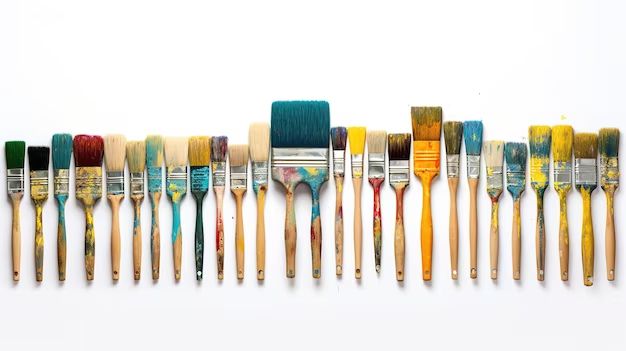When painting stucco surfaces, having the right brush is essential for achieving a smooth, even finish. The texture of stucco requires a brush that can apply paint without leaving streaks or brush marks. The most common and effective brush types for stucco painting are nylon or polyester bristle brushes, masonry brushes, and stain brushes.
Page Contents
Stiff Bristle Brushes
A stiff bristle brush, also known as a nylon or polyester bristle brush, is the best choice for painting textured stucco. The stiff bristles allow the brush to get into the grooves and indentations of the stucco finish. These types of brushes come in various widths from 1-4 inches. A 2-3 inch wide nylon or polyester bristle brush is ideal for most stucco painting jobs.
When using a stiff bristle stucco brush:
- Choose a brush labeled for exterior use as these are more durable.
- Look for a brush with flagged or split bristle tips which helps increase paint holding capacity.
- Use an angled or chisel edge brush to cut in edges and corners.
- Use a high quality brush that won’t shed bristles onto the fresh paint.
Applying stucco paint with a stiff bristle brush allows you to work the paint into the grooves for excellent coverage. Move the brush in a circular motion when painting for the smoothest finish.
Masonry Brushes
For heavily textured stucco finishes, a masonry brush is a good option. This type of brush has a thick, dense base of semi-flexible poly or nylon bristles. The bristles are often tapered to help reach into deep grooves.
Features to look for in a masonry stucco brush include:
- Bristle thickness of 0.5 inches or more
- A brush width around 4 inches
- A handle over 9 inches long
Masonry brushes allow you to apply pressure to push the bristles firmly into uneven stucco. The thick bristles also help hold more paint. Make sure to dab or lightly brush the paint on to avoid excessive dripping.
Stain Brushes
For smooth finish or fine grade synthetic stucco, a synthetic bristle stain brush can also work well. The thinner bristles on stain brushes are more flexible and can conform to minor surface variations.
Features to look for in a stain brush for stucco:
- Bristle thickness less than 0.25 inches
- Angled tip
- Width around 2-3 inches
- Polyester or nylon bristles
Lightly dab the stain brush onto the stucco to apply an even coat of paint. Stain brushes work best for latex-based stucco paints.
Brush Material Considerations
When selecting a stucco painting brush, pay attention to the material and design of the bristles. Here are some tips:
- Nylon bristles are durable and suited for heavy stucco textures.
- Polyester bristles hold more paint and provide smooth application.
- Angled splayed bristles help reach corners and edges.
- Tapered bristle tips allow for precise paint placement in grooves.
- Split-end bristle tips prevent visible brush strokes.
Avoid using rollers to paint stucco siding. Rollers are not able to penetrate into the grooves and release air bubbles. Brushes provide much better results.
Additional Tips for Painting Stucco
In addition to having the right brush, here are some extra tips for successfully painting stucco:
- Clean the stucco thoroughly before painting and allow to fully dry.
- Use 100% acrylic latex paint formulated for masonry and stucco.
- Apply paint on a dry day when temperatures are between 50-90°F.
- Watch for drips and uneven coats to brush out as you go.
- Work from the top down when painting walls.
- Use a small brush for cutting in edges and a large brush for broad surfaces.
- Add stucco paint additive if needed to increase viscosity and adhesion.
- Allow proper drying time between coats based on product directions.
- Apply at least two coats for complete coverage and protection.
Conclusion
Choosing the right brush makes a big difference when painting textured stucco siding and walls. Stiff nylon/polyester bristle brushes, masonry brushes, and stain brushes are good options. Focus on brushes with thick, stiff bristles and angled tips. Move the brush in a circular motion when painting. Allowing proper dry times and using 100% acrylic exterior paint also helps achieve the best results painting stucco. With the right supplies and technique, you can get a durable and attractive painted finish on stucco surfaces.
